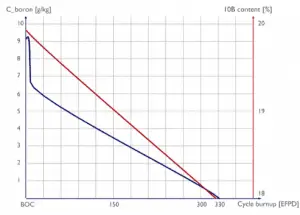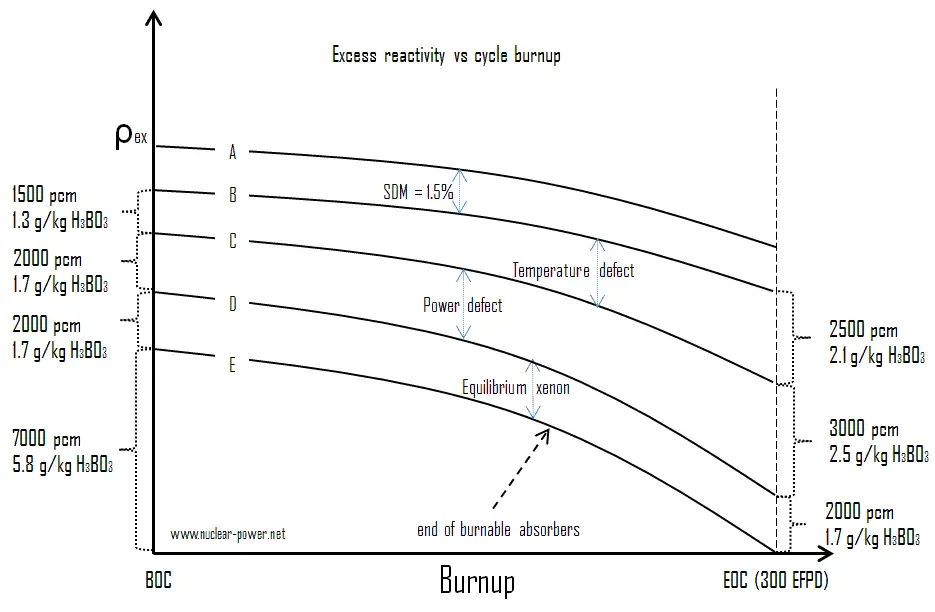
The amount of fissile material contained in the core constantly decreases during the reactor’s operation. If the reactor operates for a long period, fuel in excess (or excess reactivity) of that needed for exact criticality must be added when the reactor is refueled. For example, a typical 18-month fuel cycle requires an excess reactivity for 500 EFPDs. It means the core must be refueled after 500 days at 100% rated power or after 1000 days at 50% rated power.
The excess reactivity, ρex, is defined as the reactivity of a core if all control poisons (control rods, burnable absorbers, boric acid) were instantaneously eliminated from the core. Large excess reactivities are undesirable because they require large amounts of neutron poisons to be present in the core to compensate for them. Moreover, large excess reactivities require long fuel cycles (e.g., cycles longer than 24 months). These cycles are not economical due to the very high accumulation of fission products (see: Reactor Slagging).
The excess reactivity must be able to compensate:
- Moderator defect. Since the moderator temperature effect is usually negative, and the excess reactivity must be able to compensate for the reactivity difference between cold zero power (CZP) and hot zero power (HZP) states.
- Power defect. The total amount of feedback reactivity that must be offset by control rod withdrawal or boron dilution during the power increase (between 1% and 100% of rated power) is known as the power defect. Since the total power coefficient is always negative, the excess reactivity must also compensate for power defects.
- Stationary xenon poisoning. The excess reactivity must be able to compensate equilibrium xenon, which produces a significant amount of negative reactivity when the reactor is operated at nominal power.
- Fuel burnup. The excess reactivity must be able to ensure reactor criticality at full power for a long period while the core burnup increases (i.e., the fissile content decreases and fission products increase).
The following plot of excess reactivity versus time from beginning to end of the cycle (from BOC to EOC) illustrates this point by depicting the transitions between five states of the reactor. These transitions can be expressed by the required boric acid concentration, compensating for the excess reactivity.
- Cold Shutdown + Shutdown Margin,
- Cold Zero Power – critical
- Hot Zero Power – critical
- Hot Full Power – no xenon
- Hot Full Power – equilibrium xenon
The positive reactivity due to the excess fuel must be balanced with negative reactivity from neutron-absorbing material. Moveable control rods containing neutron-absorbing material are one method used to offset the excess fuel. Compared with the chemical shim, which offset positive reactivity excess in the entire core, with control rods, the unevenness of neutron-flux density in the reactor core may arise because they act locally.
In pressurized water reactors, chemical shim (boric acid) is used to compensate for the excess reactivity of the reactor core along the fuel burnup (long-term reactivity control) as well as to compensate for the negative reactivity from the power defect and xenon poisoning during power increase to nominal power. To control large amounts of excess fuel without adding additional control rods, and burnable poisons can be loaded into the core. Ideally, these absorbers should decrease their negative reactivity at the same rate the fuel’s excess positive reactivity is depleted. In PWRs, burnable absorbers are used to decrease the initial concentration of boric acid (also to decrease BOC MTC) and decrease the relative power of fresh fuel assemblies.
The figure can also be understood from the other side. Suppose the operator wants to shut down the reactor from Hot Full Power – equilibrium xenon to Hot Zero Power – with xenon, for example, in the case of reactor SCRAM. In that case, he must insert negative reactivity to compensate for the power defect. Obviously, if the power defect for PWRs is about 2500 pcm (about 4 βeff), the control rods must weigh more than 2500 pcm to achieve the subcritical condition. The control rods must weigh more than 2500 pcm plus the value of SDM (SHUTDOWN MARGIN) to ensure a safe subcritical condition. The total weight of control rods is designed specifically, but, for example, it may reach about 6000 to 9000 pcm. To ensure that the control rods can safely shut down the reactor, they must be maintained above a minimum rod height (rods insertion limits) specified in the technical specifications.
